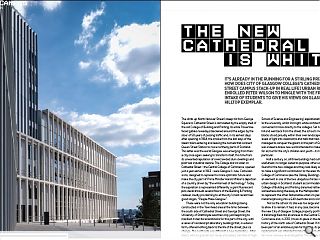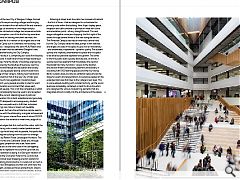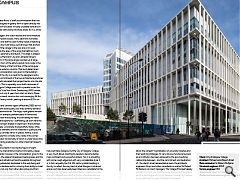City Campus: The New Cathedral is White
23 Oct 2017
It’s already in the running for a Stirling Prize but how does City of Glasgow College’s Cathedral Street Campus stack-up in real life? Urban Realm enrolled Peter Wilson to mingle with the first intake of students to give his views on the city's very own ivory tower.
The College and its sister on Cathedral Street - the Central College of Commerce, opened just a year earlier in 1963 - were Glasgow’s new, Corbusian icons, designed to represent a more optimistic future and make the city part of Prime Minister Harold Wilson’s depiction of a country driven by “the white heat of technology.” Today the aspiration is represented differently: a giant fluorescent pink decal shrouds several floors of the Building & Printing cadaver, loudly proclaiming to all the city’s most recent feelgood slogan, “People Make Glasgow”. These were not the only education buildings being constructed in the Townhead area at the time: between the south side of Cathedral Street and George Street, the University of Strathclyde was then only just beginning to manifest its territorial ambitions for this part of the city, with a series of nondescript laboratory buildings that, in exterior form, offered nothing back to the life of the street; plus ca change. The north side was different: a new secondary - Allan Glen’s, with its grander, but rarely articulated, sub-title of ‘High School of Science and Engineering’ aspirationally link-ing it to the university, whilst its bright, white architecture visibly connected it more directly to the colleges. Set higher on the hill and well back from the street, the school’s modernist blocks stood proudly within their own landscape, allowing levels of light into classrooms and halls that had not hitherto managed to conquer the gloom in this part of Glasgow.
This was indeed a brave new world intended to make life better for all, but for the city’s children and youth - its future - in particular. Half a century on, all three buildings had outlived their usefulness: no longer suited to purpose, other uses have been found for the two colleges and they look likely once again to make a significant contribution to the area: the Central College of Commerce (aka the Oakley Building) is to become an element in one of the two ubiquitous forces of cur-rent urban design in Scotland: student accommodation; whilst the College of Building and Printing (renamed rather pretentiously somewhere along the away as the Metropolitan Tower) is to represent the other fashionable urban im-perative by metamorphosing into a 640-bed hotel and conference centre. Not so the school: its site was too large and too valuable to allow it to remain. It had, in any case, become part of the new City of Glasgow College property portfolio when it transmogrified into an annexe to the Central College of Commerce and, in 2013, it took its place in the demolition history of the north side of Cathedral Street. If its origins had been part of an ambitious plan for the area, its proposed replacement was intended to take this to a much higher and far more visionary level altogether.
The site has become the principal home of the new City of Glasgow College, formed from a merger of three pre-existing colleges and bringing further education students from all walks of life and interests together in happy co-existence in one mega-campus building. Only the old nautical college has remained outside of this holistic conception: one of the the ? ve top education centres in the world for training merchant sea-man, the decision was made for it to remain on its original site on the south side of the Clyde, but in a dramatic new building - the Riverside Campus - designed by the same MLA/Reiach and Hall architectural team that has delivered Glasgow’s new, vanguard educational facility, the City Campus. And what a facility it is, comprising as it does ? ve faculties, each of which could in itself have formed a major building or group of buildings. Here the faculty of building, engineering and energy is joined by the faculties of business, crea-tive industries, leisure and lifestyle and education and society. Conventionally, young people leaving school would move to the next stage of their careers, making new friends and leaving old ones behind. Not at the new City of Glas-gow College: here a much more egalitarian model has been employed in which young people are able to step for-ward into a further education environment that values each discipline and skill equally. This is not the competitive or elitist world we have complacently become used to and accepted as the norm: in the current, dispiriting level of polit-ical debate over education this is bold, aspirational and genuinely courageous stuff , designed to encourage every student to follow his or her own path and to ful? l their individual potential. Buildings can make or break such laudable ambitions, however, but here the architecture can be seen to be entirely in tune with the philosophy, a singular achievement in a complex with a gross internal floor area of almost 59,000 sq/m and an exterior that extends to meet every edge of its site.
It is the street edges that first confront the visitor, with the west elevation facing onto a newly-created pedestrianised street that rises up the hill and, with its parallel, Acropolis-like ascent, separating the building from the soon-to-emerge new public park by Rankin Fraser Landscape Architects. The south elevation fronts onto Cathedral Street and, through its disciplined rigour, proportion and scale, faces down the architectural zoo on the other side of the carriageway. The architects like to represent the columnar grid that sits proud of the fenestration as being in a Glas-gow tradition of buildings such as the Grosvenor Hotel or the Ca’d’oro but, with its arcaded street level shopping precinct (outlets for student skills training and products), it is surely not so much a Venetian model as a Bolognese one that is at work here: the latter city’s elegant, endless porticoes protecting its citizens from the Emilia Romagna region’s inclement climate, an area Glasgow has a long-established affi nity with and a weather condition that Cathe-dral Street is well able to match.
Entering at street level, the visitor has crossed a threshold - the ? rst of three - that are designed to orchestrate the primary route within the building. Here, foyer, display space, reception and cafe combine to provide an initial wel-come and orientation point - all very straightforward, The next stage is altogether more jaw-dropping: the ? rst sight of the ascent through several levels of the vast triangular atrium. The Riverside Campus also has an enormous central void but the City Campus takes the idea, pumps it with steroids and angles one side of the space to give it an ex-traordinary - and deliberately inspirational - dynamic quality. The student quickly and implicitly understands this place and this space to be all about personal aspiration and growth. The climb to the ? rst public level is purely staircase but, on arrival, it quickly becomes apparent that this plateau (the second threshold) has many functions - access to the facility’s only lecture theatre (these being deemed unnecessary in a building with 1000 learning spaces) and the four-storey library’s public areas, but also as exhibition space and as the stage for events and presentations to audiences seated on the extended stair area that rises to the College’s next level. This is a zone already bustling with constant activity, yet the sound levels are remarkably contained, a credit to Arup Acoustics who designed the various modulat-ing elements that are integrated almost invisibly into the architecture of the space.Indeed, the several floors of staff accommodation that rise from here are designed in gallery form to open directly into the void and which would be virtually unusable were atrium noise to percolate obtrusively into these areas.
As it is, all are fully occupied. Ascending again, the visitor reaches the third threshold and the limits of public access. Here, electronic turnstiles al-low students and staff to reach further levels of teaching areas located in the multi-storey central tower that anchors the front part of the college to the rear and, in its west elevation, acts as the apex of the angle that de? nes much of the building’s geometry and layout. This angle is shaped by the grid of the Merchant City and Cathedral Street’s di-vergence from it: this same angle is picked up at large scale in the plan form of the atrium and at micro scale in the precise vertical ? uting of the front face of the rectangular precast concrete exterior columns. That such determined and continuing consideration was given to the building’s relationship with the city is a credit to the designers and a measure of the commitment of the two architectural practices involved who both relocated their project teams onto the site for 9-12 months. This is especially so as both campuses of the City of Glasgow College were built in parallel under the Scottish Futures Trust Non-Pro? t Distributing (NPD) model, with a timescale of only 4 years from start on site to Phase 2 handover. This meant construction costs averaging £4.5m were signed-off every month, peaking at around £20m on one occasion. Such speed and contract types (eff ectively D&B) do not always equate with build quality, but they certainly demand strategic and decisive action.
The huge, triple glazed window sections were, for example, prefabricated in France and installed from inside the building, thus obviating the need for extensive - and expensive - scaff olding, yet even here the external ? ns have been angled in response to the building’s geometric disciple. Conversely, the beautifully sharp, white precast concrete elements are not matched in quality by the structural in-situ concrete which in places, frankly, is a bit rough. Fortunately this is mostly only visible in the corner staircases, the basic functionality of which is under-stood and, in any case, primarily predicated on other important aspects such as fire safety. What is most evident in touring the figure-of-eight City Campus (the internal atrium being mirrored by a deep external courtyard), however, is the consideration given to the learning spaces, the adjacent breakout/meeting areas and the range of cafes and refreshment points available throughout: this is a building absolutely dedicated to the well-being and enjoyment of its clientele and to nurturing their ability to meet contemporaries not only from other disci-plines and from other parts of the city, but also from the many other countries represented within the student body. This is not just a matter of education: it is about building con? dence and pride. People may well make Glasgow, but the City of Glasgow College is very much about assisting its people to become better, more con? dent and successful citizens.
Yes, it is a building with some rough edges but with very considerable style: it is, in fact, arguably the ? rst 21st century public building in the city to re? ect the very best of what Glasgow is all about and as such has deservedly been listed as a candidate for the Stirling Prize. Perhaps, more importantly, it signposts a new and very diff erent ap-proach to further education and one that raises many questions for the higher education sector about the compart-mentalisation of university faculties and their teaching strategies. Its very obvious functional success as an institution has been achieved by the good working relationship between - and the commitment and dedication of - the client’s small representative team, the architects, engineers (Arup) and other consultants as well as Sir Robert McAlpine’s con-tract managers. The College Principal happily proclaims his two new buildings to be the future of education and the gleaming white City of Glasgow College City Campus is very de? nitely the new Cathedral on the street.
|
|
Read next: Architecture Fringe: Critical Mass
Read previous: St Andrew Square: Square Space
Back to October 2017
Browse Features Archive
Search
News
For more news from the industry visit our News section.
Features & Reports
For more information from the industry visit our Features & Reports section.





